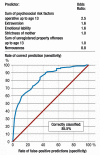What becomes of delinquent children?: results of the Marburg child delinquency study
- PMID: 20661414
- PMCID: PMC2908930
- DOI: 10.3238/arztebl.2010.0477
What becomes of delinquent children?: results of the Marburg child delinquency study
Abstract
Background: We report the results of a longitudinal study of former child delinquents in Germany, stratified according to the number of offenses they committed before and after attaining the age of criminal responsibility (14 years).
Methods: A control group consisted of persons who had had no contact with the police as children. A total of 263 individuals aged 18 years and above (mean age, 22 years) were studied with a standardized personal interview about their life history, family, health, schooling, and vocational training, as well as an intelligence test (WIP), a personality questionnaire (FPI), and a questionnaire about parental child-rearing styles. They were also given a questionnaire developed especially for this study about delinquent activities before age 14 for which they had not been apprehended by the police. Data on their interactions with the law enforcement authorities were taken from their uncensored childhood and adult criminal records up to age 40.
Results: At the most recent data collection (1996), the subjects had reached a mean age of 42 years. They were classified into three groups: non-offenders, "persisters" (former child delinquents who continued to commit crimes), and "desisters" (former child delinquents who stopped committing crimes). Logistic regression analysis enabled the retrospective prediction of multiple delinquency in childhood and adolescence, as well as of delinquency over the course of life. The main prognostically relevant factors were the summated social and familial risk factors, followed by personality traits and the number of unregistered (self-reported) property offenses in childhood.
Conclusion: These findings show that early delinquency does not necessarily develop into a long-term criminal career, and that the risk factors for criminality are nearly the same as those for mental disturbances. Only three risk factors seem to be specific to criminality: male sex, the early onset of aggressiveness, and the negative influence of delinquent peers.
Figures

References
-
- Hinshaw SP, Zupan BA. Assessment of antisocial behavior in children and adolescents. In: Stoff DM, Breiling J, Maser JD, editors. Handbook of antisocial behaviour. New York: Wiley; 1997. pp. 36–50.
-
- Vermeiren R. Psychopathology and neu-ropsychological deficits in delinquent adolescents. Antwerpen: Universiteit Antwerpen; 2002. Delinquents disordered?
-
- Loeber R, Farrington DP, editors. Child delinquence. Thousand Oaks, California: Sage publications; 2001.
-
- Remschmidt H, Walter R. Gesetzesverstöße Strafunmündiger und ihre Folgen. Heidelberg: Springer; 2009. Kinderdelinquenz.
-
- Boers K, Loesel F, Remschmidt H, editors. Entwicklungskriminologie und kriminologische Lebenslaufforschung. MschrKrim. 2009;(Sonderheft 2/3)
MeSH terms
LinkOut - more resources
Full Text Sources

